COMPARISON OF THE CONCORDANCE CHAPTERS OF THE THERAPEUTIC POCKET BOOK (TPB – GERMAN, TPB -HEMPEL & TPB – ALLEN) AND BOGER’S BOENNINGHAUSEN’S CHARACTERISTIC AND REPERTORY (BBCR)
Dhaval R. Akbari, MD (Hom)1*
Anoop M. Nigwekar, MD (Hom), MBA, Adv. Dip. Mgmt 2
- Assistant Professor, Dept. of Repertory, P.G. Department, Baroda Homoeopathic Medical College and Hospital, Vadodara, Gujarat.
2 Professor & Head, Department of Repertory, Dr. M. L. Dhawale Memorial Homoeopathic Institute (MLDMHI), Palghar, Maharashtra.
*Address for correspondence: Dr. Dhaval R. Akbari
Email: dr.dhavalakbari@gmail.com
How to cite this article:
Akbari DR, Nigwekar AM, Comparison of Concordance Chapter of Therapeutic Pocket Book (TPB- German, TPB- Hempel & TPB- Allen) And Boger Boenninghausen’s Characteristic And Repertory (BBCR) by Boger. Journal of Integrated Standardized Homoeopathy (JISH) 2019; 02(02)
Received on: June 10, 2019
Accepted for Publication: July 17, 2019
Abstract:
During the study of the Concordance chapter of the Therapeutic Pocket Book edited by Allen and the Boger Boenninghausen’s Characteristics Materia Medica and Repertory (BBCR), some changes were identified in the representation of remedies and the grades of the remedies in the various rubrics. These books are commonly used, hence we decided to study the chapter to identify the differences. This study will compare and contrast the concordance chapter of the Therapeutic Pocket Book – (German, Hempel, Allen) and BBCR. Three polychrest remedies were chosen to demonstrate the difference. It is a huge task to study all the represented remedies. The conclusion we are drawing is that the reference of the BBCR Concordance is more in sync with what Boenninghausen proposed. Homoeopathic physicians should use this.
Keywords:
Comparison, Remedy Relationship, concordance, Therapeutic Pocket Book (German, Hempel, Allen), BBCR
Introduction
Concordance or relationship of remedies is an important contribution to the Homoeopathic profession by Dr. Boenninghausen. The Concordance chapter appears in the Therapeutic Pocket Book (TPB) as well as in Boger Boenninghausen’s Characteristics and Repertory (BBCR). A cursory look at some remedies in the Concordance section of Therapeutic Pocket Book edited by Dr. T.F. Allen (TPB-A) and BBCR indicates that they are not identical. Boger is an authority on Boenninghausen; therefore, it is important to understand why the difference. This led to the current study in which we compared the original German edition of Therapeutic Pocket Book by Boenninghausen (TPB-G), translation by Hempel (TPB-H) and by Allen (TPB-A) and the BBCR.
Methodology:
We attempted to compare and contrast these various editions for the Concordance section only, focusing on these points:
- Comparison of the marks allocated to remedies through the typology.
- Identification of remedies represented in the various rubrics in the Concordance section.
- Comparing the marks allocated to remedies in each of the editions.
- Comparing the time and circumstance rubrics of a remedy in various editions.
- Identifying the remedies added and marking changed by Allen.
These parameters were chosen to identify the change and its significance for today’s students of Homoeopathy. We also wanted to identify the process to be adopted and also the issues that one experiences while deriving conclusions.
The sources of the original books – TPB – German and TPB – Hemple were traced from the internet and their authenticity was assumed. The TPB – Allen and BBCR were physically checked for the representation.
Observations:
- Comparison of markings of remedies (typography).
| MARKINGS | TPB-G | TPB-H | TPB-A | BBCR |
| 5 MARKS | P u l s | PULS | PULS | PUL |
| 4 MARKS | Puls |
PULS |
Puls | Pul |
| 3 MARKS | P u l s | Puls | Puls | Pul |
| 2 MARKS | Puls | Puls | Puls | Pul |
| 1 MARKS | ( Puls ) | ( puls.) | ( Puls.) | (pul) |
Table .1: Comparative Typography
Each author has made his own typography, although the marking remains the same! Why was this done is an unanswered question! Boger has altered the abbreviation of the remedy in comparison to other editions, but the reason remains unknown (Table 1) [1-5].
- Identification of remedies represented in the various rubrics in the Concordance section
We checked the number of remedies – 125 – in the TPB-G and the TPB-H. Allen, in his introduction to the Concordance section, stated that he added 21 remedies. We traced through all the four books the remedies that were added. The process we adopted was placing in the excel sheet all the remedies and compared their presence by marking the number “1” (Table 2). This ensured the sum total of each column will yield the number of remedies and we could trace exactly which remedies he added and which he deleted (ref. Table 3) [3, 4 6-8].
| SR. NO | Medicine | TPB-G | TPB-H | TPB- A | BBCR |
| 1 | Aconite | 1 | 1 | 1 | 1 |
| 2 | Aesculus | – | – | 1 | – |
| 3 | Agaricus muscarius | 1 | 1 | 1 | 1 |
| 4 | Agnus (vitex agnus castus) | 1 | 1 | 1 | 1 |
| 5 | Allium cepa | – | – | 1 | – |
| 6 | Aloe | – | – | 1 | – |
| 7 | Alumina | 1 | 1 | 1 | 1 |
| 8 | Ambra grisea | 1 | 1 | 1 | 1 |
| 9 | Ammonium carbonicum | 1 | 1 | 1 | 1 |
| 10 | Ammonium muriaticum | 1 | 1 | 1 | 1 |
| 11 | Anacardium | 1 | 1 | 1 | 1 |
| 12 | Angustura | 1 | 1 | – | 1 |
| 13 | Antimonium crudum | 1 | 1 | 1 | 1 |
| 14 | Antimonium tart | 1 | 1 | 1 | 1 |
| 15 | Apis | – | – | 1 | – |
Table 2: Marking remedies added / removed
| Sr. No. | Removed by Allen | Additions by Allen |
| 1 | Angustura | Aesculus |
| 2 | Magnes | Allium Cepa |
| 3 | Magnes arcticus | Aloe |
| 4 | Magnes australis | Apis |
| 5 | Argentum Nitricum | |
| 6 | Arum Triphyllum | |
| 7 | Baptisia | |
| 8 | Berberis | |
| 9 | Cactus | |
| 10 | Cannabis Indica | |
| 11 | Cimicifuga | |
| 12 | Crotalus | |
| 13 | Gelsemium | |
| 14 | Glonoine | |
| 15 | Kali Bichrom | |
| 16 | Lilium Tig | |
| 17 | Lithium | |
| 18 | Phytolacca | |
| 19 | Podophyllum | |
| 20 | Sanguinaria | |
| 21 | Veratrum Viride |
Table 3: Remedies added or removed by Dr. Allen
- Comparing the marks allocated to remedies in each of the editions
We chose three polychrest remedies randomly as samples to study their representation in the various books under study; namely, Aconite, Pulsatilla and Sulphur, noting their markings against every rubric of their Concordance section e.g. Aconite – the mind rubric. First remedy Anacardium has 2 marks in TPB-G, 2 marks in TPB-H, 3 marks in TPB-A and 2 marks in BBCR. That means Allen changed the marking of Anacardium from 2 in the original to 3. So it has been marked with the number “1” in column “remedies with marking change by Dr. Allen”. Now if we take one more, Aloe, it is absent in TPB-G, TPB-H and BBCR but added and given 3 marks in TPB-A. Therefore, in the column remedy added by Allen, the number “1” has been written. After that, the sum total of remedies added by Dr. Allen and the remedy markings changed by Dr. Allen has been done [4, 6, 7, 8].
| Mind | Remedy | Markings TPB-G | Markings TPB-H | Markings TPB-A | Markings BBCR | Remedies added by Allen | Remedies with marking change by Allen |
| Anac. | 2 | 2 | 3 | 2 | 1 | ||
| Aloe | 3 | – | 1 | ||||
| Apis | 3 | – | 1 | ||||
| Arg. N. | 3 | – | 1 | ||||
| Ars | 2 | 2 | 3 | 2 | 1 | ||
| Bap | 4 | – | 1 | ||||
| Bell | 4 | 4 | 4 | 4 | |||
| Bry | 2 | 2 | 2 | 2 | |||
| Cact | 4 | – | 1 | ||||
| Calc. C | 2 | 2 | 2 | 2 | |||
| Camph | 2 | – | 1 | ||||
| Cannab. I | 5 | – | 1 | ||||
| Canth | 2 | – | 1 | ||||
| Carb. Ac. | 3 | – | 1 |
Table 4: Markings of remedies in the concordance section
| TPB-G | TPB-H | TPB-A | BBCR |
| I. | I. | Mind | Mind |
| II. | II. | Localities | Localities |
| III. 1. | III. 1. | Sensations | Sensations |
| III. 2. | III. 2. | Glands | Glands |
| III. 3. | III. 3. | Bones | Bones |
| III. 4. | III. 4. | Skin | Skin |
| IV. | IV. | Sleep and dreams | Sleep and dreams |
| V. | V. | Blood, circulation and fever | Blood, circulation and fever |
| VI. 1. | VI. 1. | Aggravation: time and circumstances | Time |
| VI. 2. | VI. 2. | Aggravation | |
| VII. | VII. | Other remedies | Related remedies |
| Antidote | Antidote | Antidotes | Antidote |
| List of injurious remedies written under antidote in bracket. E.g. (Noc*.- name of medicine) | List of injurious remedies written under antidote in bracket. E.g. (Noc.- name of medicine | List of injurious remedies – given as separate rubric after antidotes. | List of inimical remedies written under antidote in bracket. E.g. (Inimical – name of the remedies) |
Noc*. = Noxious. [2, 4, 6-8]
Table 5: Comparison of Presentation of Rubrics in Concordance section.

[Image 1: Concordance of Phosphorus in Boenninghausen’s Therapeutic Pocket Book –German Edition. Source: https://play.google.com/store/books/details?id=8Rs4AAAAMAAJ]

[Image 2: concordance of phosphorus from Therapeutic Pocket Book- Hempel Edition. Source: https://archive.org/details/therapeuticpock00hempgoog]
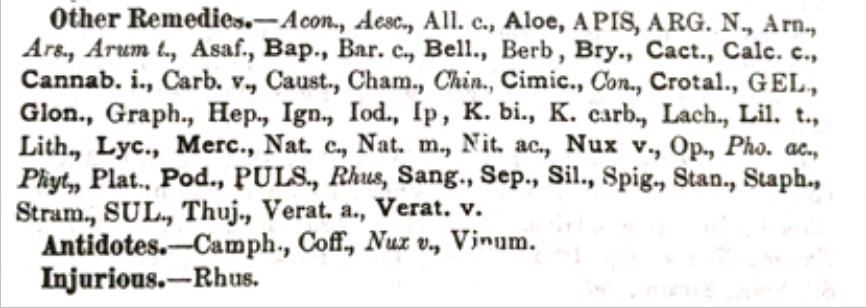
[Image 3: concordance of phosphorus from Therapeutic Pocket Book- Allen Edition. ( see, injurious after antidote). Source: Boenninghausen’s Therapeutic Pocket Book. B Jain Publishers (P) Ltd.]
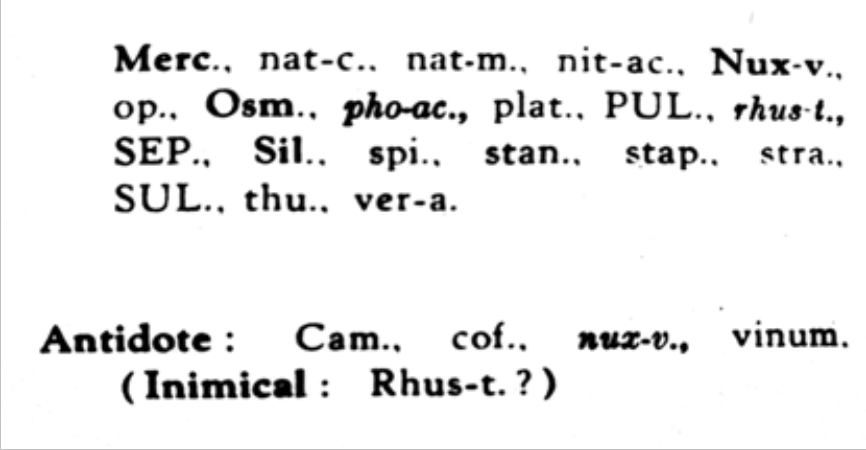
[Image 4: concordance of phosphorus from BBCR ( see ‘inimical’ in bracket in antidote rubric.). Sourse: Boenninghausen’s Repertory, by Boger CM, B. Jain Publishers (P) Ltd.]
| RUBRICS | ACONITE | PULSATILA | SULPHUR | |||
| AR | CM | AR | CM | AR | CM | |
| Mind | 31 | 8 | 15 | 1 | 15 | 0 |
| Localities | 33 | 1 | 36 | 1 | 35 | 0 |
| Sensation | 23 | 0 | 30 | 1 | 29 | 0 |
| Glands | 0 | 0 | 1 | 0 | 1 | 0 |
| Bones | 0 | 0 | 1 | 0 | 2 | 0 |
| Skin | 1 | 0 | 4 | 0 | 9 | 0 |
| Sleep and dreams | 7 | 0 | 9 | 0 | 9 | 0 |
| Blood, circulation, and fever | 12 | 0 | 14 | 0 | 15 | 1 |
| Aggravations: time and circumstances | 18 | NA | 18 | NA | 19 | NA |
| Other remedies | 21 | 2 | 22 | 1 | 22 | 0 |
| Antidote | 0 | 0 | 0 | 0 | 0 | 0 |
AR= Addition of remedies, CM= Change in markings, NA= Not applicable
Table 6: Comparison of additions of remedies in each Rubric of the Concordance section
Allen added remedies in the rubrics of Mind, Localities, Sensation, Blood, Circulation and fever, Aggravation, and Other remedies, but changing markings in very few remedies. Allen added very few remedies in the rubric ‘Sleep and Dreams’. Allen did make additions in the glands, bones, and skin rubrics but did not change the markings. He did not alter the Antidote section. He made no changes in markings in Glands, Bones, Skin, Sleep and dreams, Blood, Circulation & fever rubric, and Antidote sections. We observe that Allen changed the markings, but Boger reverted to the original Text. We do not know what made Allen change the marking and Boger to revert. However, we may assume that Allen based his changes on his experience of practice, about which Boger was skeptical; therefore, he found it better to stick with the original text.
- Comparison of time and circumstance rubrics of a remedy in various editions.
In the TPB-A relationship of remedies chapter, it is written that merger of aggravation – time and aggravation – circumstances was done under one heading Aggravation – Time and Circumstances. TPB-G, TPB-H and BBCR have given two separate rubrics for the same. We decided to compare Allen to the other three editions. TPB – G & H have adopted the rubric as VI. 1. (Time) & VI. 2. (Circumstance). In this study, we assigned the number 0 for time & 2 for circumstance e.g. Anac. 0 + 2 means time does not having this remedy but circumstance have this in 2 marks. Whereas, Allen has merged it so it has given as single markings in TPB-A [3, 4, 7, 8].
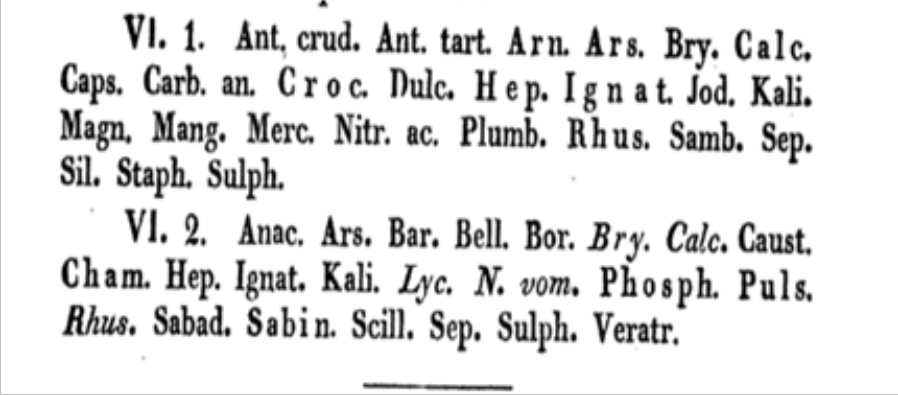
[Image-5: Concordance chapter- Aconite, Therapeutic Pocket Book- German Edition. Source: https://play.google.com/store/books/details?id=8Rs4AAAAMAAJ ]
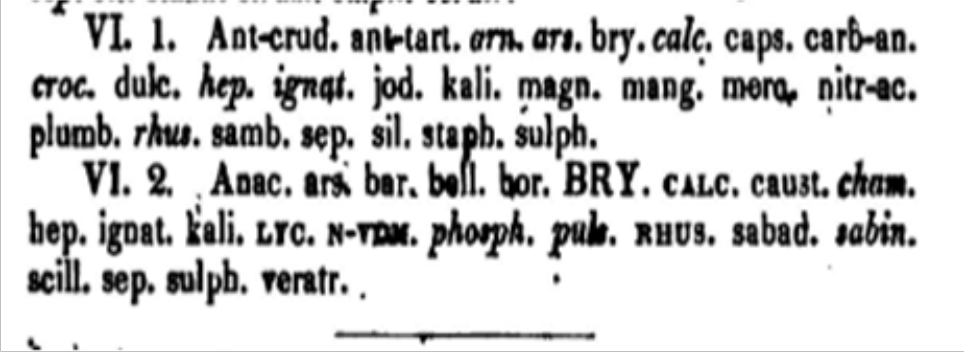
[Image-6: Concordance chapter- Aconite, Therapeutic Pocket Book- Hempel Edition. Source: https://archive.org/details/therapeuticpock00hempgoog]

[Image-7: Concordance chapter- Aconite, Therapeutic Pocket Book- Allen Edition. Source: Boenninghausen’s Therapeutic Pocket Book. B Jain Publishers (P) Ltd.]
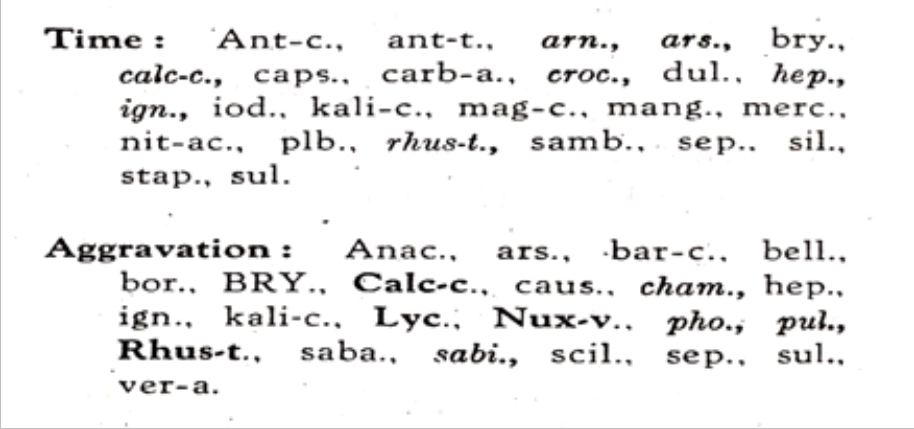
[Image-8: Concordance chapter- Aconite, BBCR. Source: Boenninghausen’s Repertory, by Boger CM, B. Jain Publishers (P) Ltd.]
| AGGRAVATIONS:TIME AND CIRCUMSTANCES | REMEDY | MARKINGS TPB-G | MARKINGS TPB-H | MARKINGS TPB-A | MARKINGS BBCR | REMEDIES ADDED BY ALLEN | REMEDIES WITH MARKING CHANGE BY ALLEN |
| TIME+AGG. | |||||||
| AESC | 2 | 1 | |||||
| ALL.C. | 1 | 1 | |||||
| ALOE | 1 | 1 | |||||
| ANAC | 0+2 | 0+2 | 2 | 0+2 | |||
| ANT.CR | 2+0 | 2+0 | 2 | 2+0 | |||
| ANT.T | 2+0 | 2+0 | 2 | 2+0 | |||
| APIS | 3 | 1 | |||||
| ARG.N. | 3 | 1 | |||||
| ARN | 3+0 | 3+0 | 3 | 3+0 | |||
| ARS | 3+2 | 3+2 | 3 | 3+2 | |||
| BAP | 1 | 1 | |||||
| BAR.C | 0+2 | 0+2 | 2 | 0+2 | |||
| BELL | 0+2 | 0+2 | 2 | 0+2 | |||
| BOR | 0+2 | 0+2 | 2 | 0+2 | |||
| BRY | 2+5 | 2+5 | 5 | 2+5 | |||
| CACT | 1 | 1 | |||||
| CALC.C | 3+4 | 3+4 | 4 | 3+4 |
Table 7: Markings of remedies in concordance section- aggravation- time and circumstances.
- Identification of the remedies added and marking changed by Allen.
We decided to study the representation of in the three polychrests to identify in which rubrics Allen had added remedy. The task of searching remedies added per rubric was significantly laborious. Hence, we decided to identify the remedies added in each polychrest we were studying. We found that he added 47 remedies in Aconite, 38 in Pulsatilla, and 39 in Sulphur.
| Remedy | Aconite | Pulsatilla | Sulphur | Remedy | Aconite | Pulsatilla | Sulphur | |
| Aesc | * | * | * | Gel | * | * | * | |
| All.c. | * | * | * | Glon | * | * | * | |
| Aloe | * | * | * | Hyd.ac | * | * | * | |
| Apis | * | * | * | Hyper | * | * | ||
| Apoc.c | * | * | * | Ip | * | |||
| Arg.n. | * | * | * | Iris.v | * | * | * | |
| Aurm.t. | * | * | * | Kali.bi | * | * | * | |
| Bap | * | * | * | Kalm | * | * | * | |
| Berb | * | * | * | Lil.t | * | * | * | |
| Cact | * | * | * | Lith | * | * | * | |
| Camph | * | Lob.i | * | |||||
| Cannab.i | * | * | * | Meli | * | * | * | |
| Cannab.s | * | * | Mellef | * | ||||
| Canth | * | Merc.c | * | * | ||||
| Carb.ac | * | * | * | Onos | * | |||
| Caul | * | * | * | Phos.ac | * | |||
| Ced | * | Phyt | * | * | * | |||
| Chel | * | Pic.ac | * | * | ||||
| Cic | * | Pod | * | * | * | |||
| Cimic | * | * | * | Pso | * | * | * | |
| Con | * | Sal.ac | * | |||||
| Croc | * | Sang | * | * | * | |||
| Crotal | * | * | * | Sec.c | * | |||
| Cup | * | Tell | * | |||||
| Dig | * | Ther | * | * | * | |||
| Dios | * | * | Thuja | * | ||||
| Dulc | * | Verat.v. | * | * | * | |||
| Eup.p | * | * | Zinc | * | ||||
| Fl.ac. | * | * |
Table 8: Mapping of the remedies added be Allen in any rubric in three polychrest.
Below is an attempt to map remedies whose markings are changed in any rubric in TPB-A in the 3 polychrests we had undertaken to study.
| Remedies | Aconite | Pulsatilla | Sulphur |
| Anac | * | ||
| Ars | * | * | |
| Chin | * | ||
| Cocc | * | * | |
| Con | * | ||
| Hyos | * | ||
| Lach | * | ||
| Merc | * | ||
| Nux.v | * | ||
| Rhus | * |
Table 9: Mapping of the remedies with marking changed by Allen
Allen has changed markings of 8 remedies in Aconite, 3 in Pulsatilla and 1 in Sulphur.
CONCLUSION:
This study provides the insight that Boger did not follow the additions done by Allen in TPB, perhaps because the Logic and diligence of Boenninghausen was uniform across his works. We decided to study the editions of TPB from 3 authors since we wanted to be sure that we are not missing out on any personal prejudice.
The two books, TPB edited by Allen and BBCR, are readily available. Hence, we were more focused on which of the two matches the original work. We conclude that the use of Concordance in the BBCR is closer to the original text as also the philosophy of Boeninghausen.
We could trace the reason for the changes made by Allen. Concordance is a concept that will evolve with clinical experience. Therefore, it is important that we physicians should share our experiences and enhance the relationship of remedies.
The current study of remedy additions by Allen can be further extended from just three remedies to more remedies, helping us to trace Allen’s logic, that too in the type of remedies.
References:
- Boenninghausen C, Preface. In: Boenninghausne C, editor. Therapeutic Pocket Book. [internet]. Munster, Druck und Verlag der Coppenrath’ schen Buch- und Kunsthandlung; 1846[cited 2007 June 21]. p. ix-x. Available from: https://books.google.co.in/books?id=8Rs4AAAAMAAJ/
- Hempel CJ. Preface. In: Hempel CJ, editor. Therapeutic Pocket Book. [internet]. New York. W. Radde; 1847[cited 2008 August 4]. p. vi, x. Available from: https://archive.org/details/therapeuticpock00hempgoog/
- Allen TF, Preface to the new American edition. In: Allen TF, editor. Boenninghausen’s Therapeutic Pocket Book. 5th American edition. New Delhi, B. Jain Publishers (P) Ltd.; 2009.
- Boger CM, Concordance. In: Boger CM, editor. Boenninghausen’s Repertory. New Delhi, B. Jain Publishers (P) Ltd.; 2006. p. 964, 1019,1021, 1035-36.
- Tiwari SK, Essentials of Repertorization. 4th New Delhi, B. Jain Publishers (P) Ltd.; 2006. p. 230.
- Allen TF, Relationship of Remedies. In: Allen TF, editor. Boenninghausen’s Therapeutic Pocket Book. 5th American edition. B.Jain Publishers (P) Ltd.; 2009. p. 322-23, 437, 444-45,471-72.
- Boenninghausen C, Concordance. In: Boenninghausne C, editor. Therapeutic Pocket Book. [internet]. Munster, Druck und Verlag der Coppenrath’ schen Buch- und Kunsthandlung; 1846[cited 2007 June 21]. p. 376-77, 467, 471-72, 495-96. Available from: https://books.google.co.in/books?id=8Rs4AAAAMAAJ/
- Hempel CJ, Concordances of the Medicaments, In: Hempel CJ, editor. Therapeutic Pocket Book. [internet]. New York. W. Radde; 1847[cited 2008 August 4]. p. 362-63, 438, 441-42, 461-62. Available from: https://archive.org/details/therapeuticpock00hempgoog/






